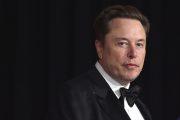
Last Friday, the leaders of the former Soviet republics of Russia, Belarus, and Kazakhstan entered into an accord strengthening the economic integration of their three nations, a step they intend to accelerate their permanent union.
The plan to create the new entity -— the Eurasian Union -— was first announced in a speech delivered by on-again, off-again ruler of Russia, Vladimir Putin.
It was in the Kremlin that the three presidents gathered to commit their countries to the policy of surrendering aspects of their individual sovereignty. The plan is called the “Declaration on Eurasian Economic Integration.” Russian President Dmitri A. Medvedev (left) was quoted in the New York Times calling the project “a new and very powerful step on the path to forming a Eurasian Economic Union.”
While Vladimir Putin is credited with hatching the idea last month, the broad strokes of the U.S.S.R-lite were painted years ago. In fact, the current president of Kazakhstan, Nursultan Nazarbayev, floated the idea in the 1990s as a solution to the economic problem plaguing many of the former satellites of the Soviet Union.
In Nazarbayev’s vision, the three present participants would have been joined by Kyrgyzstan and Tajikistan. When the first rumblings of the reunion were heard in the years immediately after the collapse of the Soviet Union, observers around the globe feared such a resurgence, but nearly 20 years on, such a suggestion causes hardly a ripple of interest.
The ultimate aim of the Eurasian Union would be a bloc of interconnected nations functioning similarly to its western neighbor, The European Union. In the Eurasian zone, however, the center of the new eastern empire would be Russian, fulfilling a familiar role in the region.
Not all the former Soviet republics are keen on seeing even an embryonic rebirth of the socialist superstate. In fact, Georgian President Mikhail Saakashvili pulled no punches, instantly dubbing the the zone “a new Soviet Union.”
Unfortunately for Mr. Saakashvili, the troika is more than just toying with the idea. In 2010, Belarus, Kazakhstan, and Russia formed a customs union, essentially uniting their independent economies and all but eliminating all existing trade restrictions among them. One of the nations originally envisioned as a partner in the plan, Kyrgyzstan, has announced its hope to soon join the customs union, as well.
The Eurasian Union would be a powerful counter-balance to the collapsing European Union. According to an article published by the online version of the San Francisco Chronicle:
The combined GDP of these four countries was $1,680 billion in 2010, with Russia making up the lion’s share ($1,480 billion). For comparison, the current 17 members of the eurozone’s GDP totaled close to $12,200 billion in 2010.
According to provisions of the treaty, Moscow will be the headquarters of the Union, with the bulk of the burden of infrastructure expenses being borne by Russia. The day-to-day financing of the Commission will be funded through a taxation scheme established by the existing customs union.
The Eurasian Commission will make decisions regarding customs, economic competition, international trade agreements (including setting of tariff rates), regulation, energy policy and financial policy.
While all of this sounds like an eastern echo of the EU, President Medvedev assures his constituents that there will be fundamental differences between the two economic zones.
In spite of the existing points of distinction, there is no avoiding the easy comparison between the Eurasian Union and the disintegrating Eurozone. And, given the disastrous days behind and ahead of the EU member nations, why would Russia, Belarus, Kazakhstan, and others even entertain the notion of binding themselves with common cords of confederacy?
One of the engines driving this train down the tracks of union is Russian Minister of Industry and Trade, Viktor Khristenko. When asked how this new union would avoid falling into the same traps that have snared their European examplars, Khristenko said:
“The current situation when the eurozone is facing internal economic problems has helped us to identify proper ways to integrate and co-ordinate our budget, financial and monetary policies. In this way, we will be able to avoid piling up internal risks and, generally, situations like this one.”
Such an optimistic outlook should be expected of Khristenko, as he has been tapped to serve as the union’s first economic commissioner.
What effect could such an integration have on the economic health of the United States? One legitimate fear was described in the San Francisco Chronicle article:
One of the main goals of an EU expansion eastward or Russia’s Eurasian Union effort will be the pursuit of oil. Both groups will complain about the sphere of influence infringement, but at the end of the day the geographic prominence of the former Soviet countries will be the prize. Azerbaijan sits on the Caspian Sea and produces 651,700 bbl/day, but has to go through either Georgia or Turkey (another EU hopeful) in order to reach the Black Sea and world markets. Several European countries, including powerful Germany, are already under the thumb of Russia in terms of access to energy, especially of natural gas. A completed Eurasian Union could control up to 33% of the world’s proven natural gas reserves (Russia currently has 25%).
With such a prosperous proposal on the horizon, it is easy to see why these nations are rushing headlong into union, despite the bumpy road being trod by Europe. The precursor to the full blown Eurasian Union is known as the Common Economic Space. This agreement follows the guidelines set up by the World Trade Organization and mirrors much of the early arrangements of the European Union.
When it comes to economic unions (whether it be the EU, the North American Union [NAU], or others), the $64 question is whether there will be a common currency adopted by members.
The Eurasian Union Economic Minister in waiting, Khristenko, says there has been no final decision made, but that the lessons of the EU will not be ignored.
“The crisis has underlined one simple thing — if you go as far as creating a single-currency union, you must exercise tight control over budget, monetary and tax policies at national levels. If this is not the case, then some regions of the eurozone will be exposed to processes similar to what is happening today in Greece, Italy and Spain,” he said.
Regardless of the piecemeal approach to one world government, there is no hiding the ultimate aim of the centripetal forces eradicating national borders.
In describing the efforts the architects of the Eurasian Union to correct the mistakes of the EU blueprint, Khristenko revealed the truth behind the construction to be a “localized globalization processes.” That is to say, it is much easier to unite once sovereign, self-governing nations into blocs of interdependent, regional satraps of a greater, all-powerful, global government than to establish the world union in one fell swoop.
Perhaps the bigger question to be pondered by citizens of the still-sovereign United States of America is whether our country will be able to avoid being pulled into the orbit of similar unconstitutional unions — whether via our own active participation in the NAU (or similar unaccountable super-congress) or by default as a result of our unsatisfiable appetite for oil and empire.



